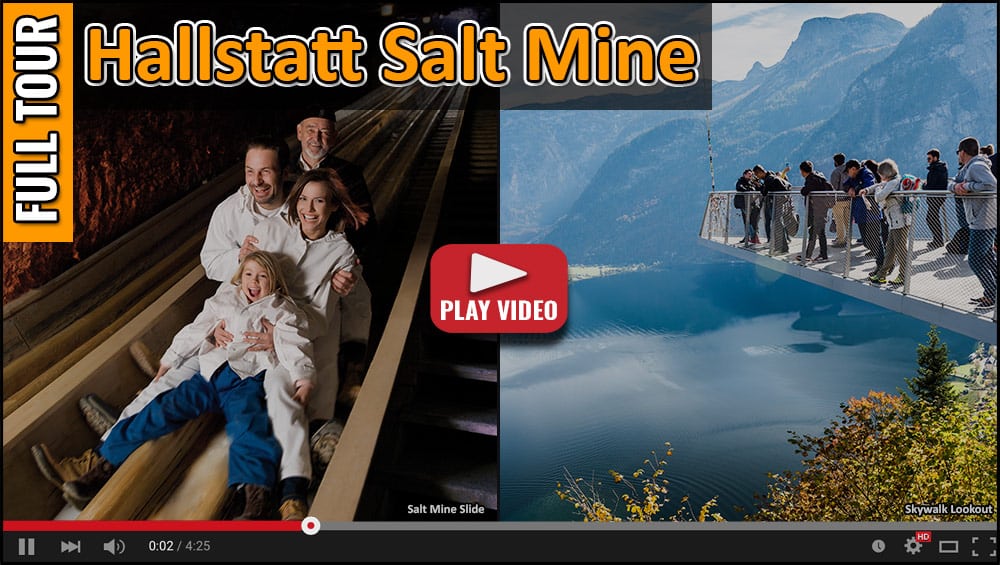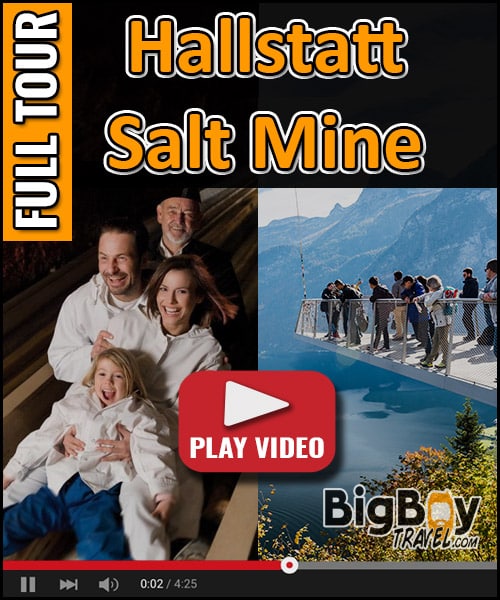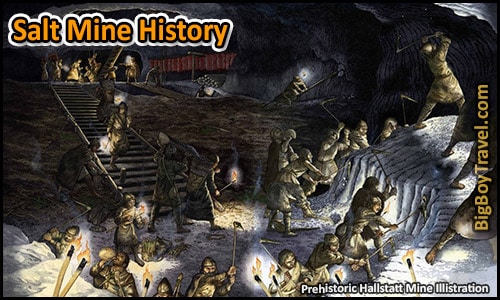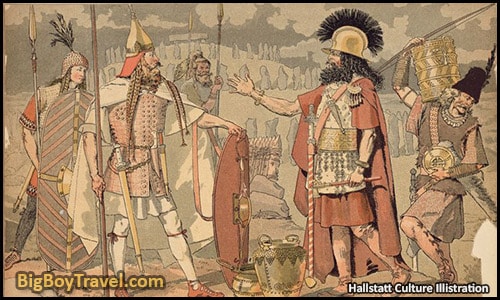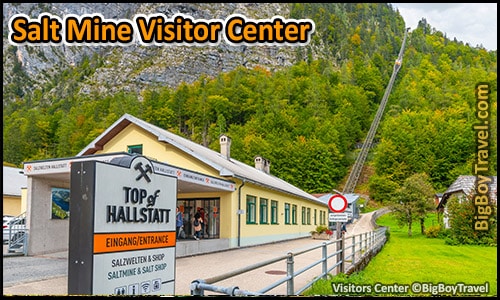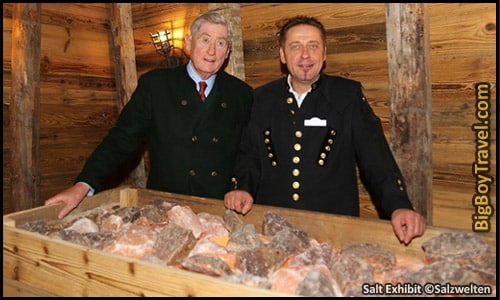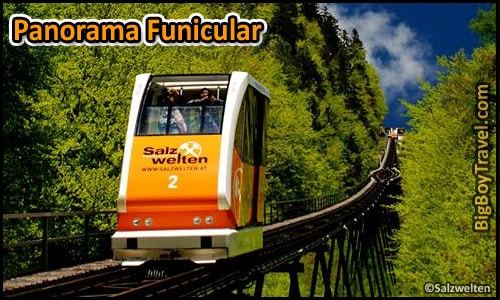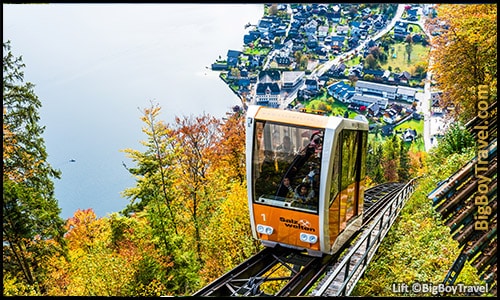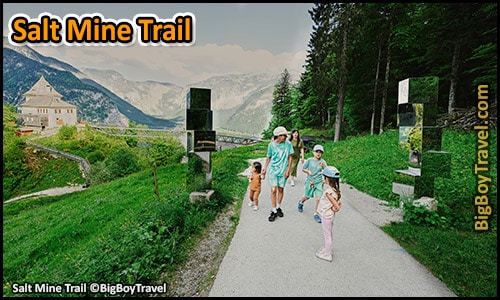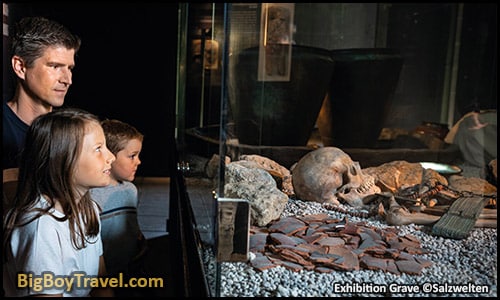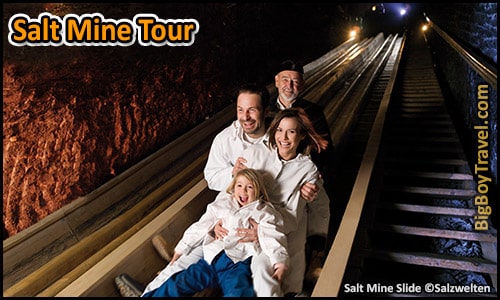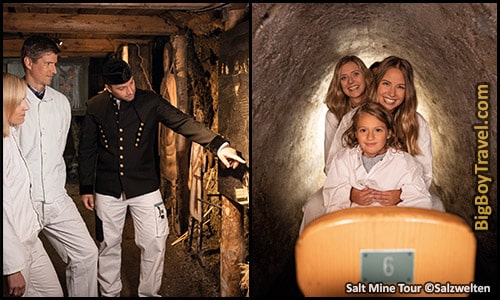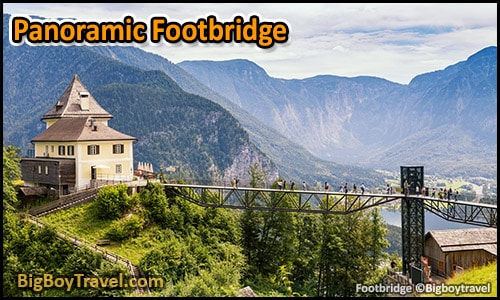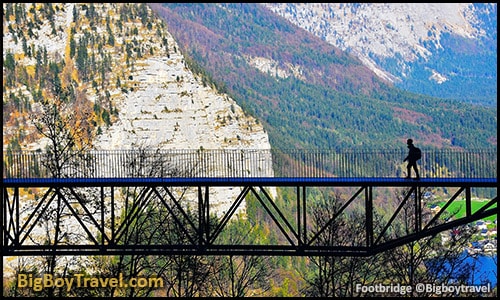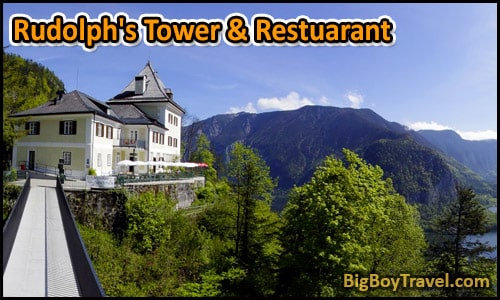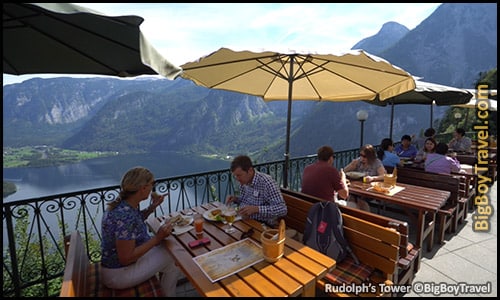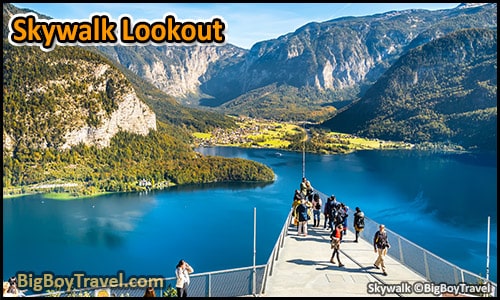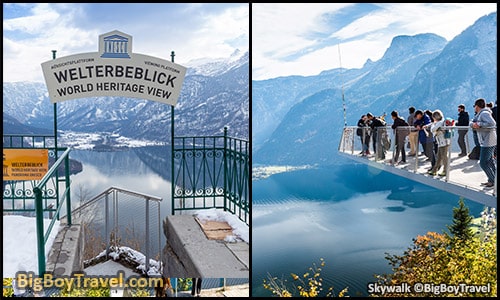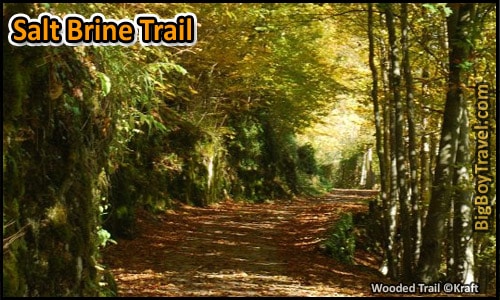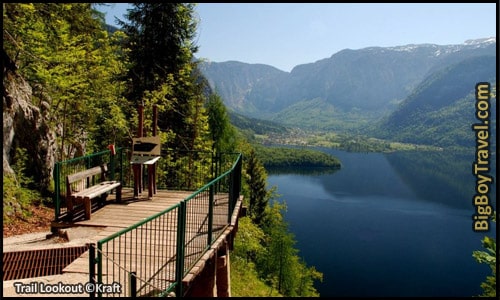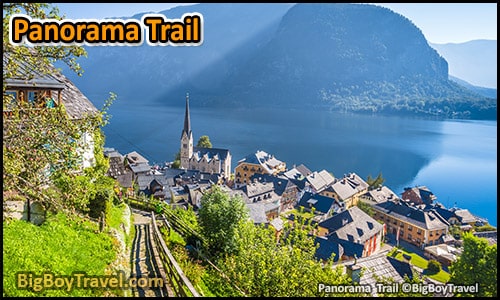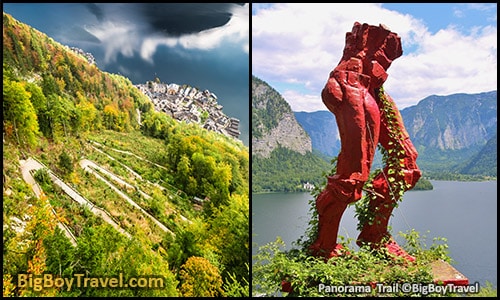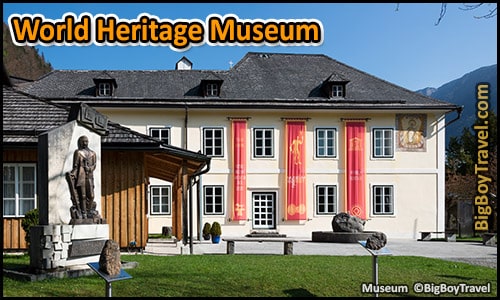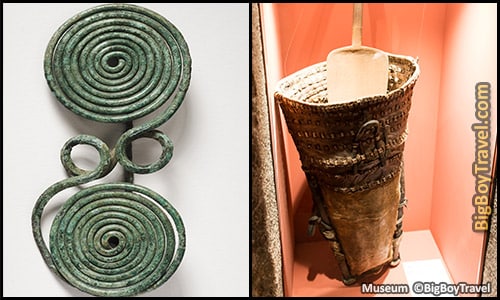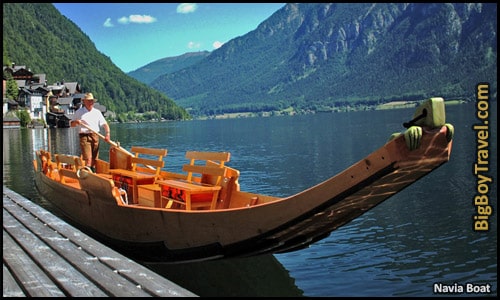Hallstatt Salt Mine Tour:
Oldest In The World: The salt mining in Hallstatt dates back to 5,000 BC, making it the oldest in the world.
Location: Hochtal High Valley, which is over 1,150 feet (350 meters) above lakeside Hallstatt.
Time Required: Around 3 hours is required for the roundtrip funicular lift, trail walk, and Hallstatt Salt Mine tour. Add an extra hour for Rudolph’s Tower & Skywalk for a total of 4 hours.
Seasonality: The Hallstatt Salt Mine tours are available daily all year except for four weeks in the Winter when they close from mid-January to mid-Febraury. The funicular lift and Skywalk lookout stay open all 365 days a year (outside of scheduled maintenance).
Fun Scale: 9 out of 10
Salt Mine Overview:
Salt Mining in Hallstatt has been going on for 7,000 years, so having the chance to tour the mine while in town is a real treat. Salt was so vital to life before modern refrigeration we often take it for granted today, but it is what put Hallstatt on the map. While the tiny village may be quite sleepy today, Hallstatt’s Celtic influence on early Europe thanks to white gold (salt) led to an entire period of the Iron Age (800-400BC) to be known as the Hallstatt Era.
If you are in Hallstatt for at least two days, you need to make sure to tour the Salt Mine! If you are only in Hallstatt for one day, however, you’re going to have to make a tough choice between visiting the Ice Cave or the Salt Mine before strolling the village as both of them are about a half-day experience. In our suggested itineraries for Hallstatt, we have tips on how you can see both.
1. Is The Hallstatt Salt Mine Worth It?: Yes, the mine is 100% worth your time and effort. It is the oldest salt mine in the world and one of the best things to do in Hallstatt. In addition to the entertaining tour and miners’ slides, you’ll also get unmatched views from above the village from the funicular and skywalk during your visit.
2. How To Get To The Salt Mine?: The Hallstatt Salt Mine sits over 420 meters (1,378 feet) high above the village, so some advanced planning is important for your visit. Knowing the proper logistics will allow you to see all of the salt mine area sights, including your tour and the skywalk, in under 4 hours.
There are essentially two options to get up the mountainside for the salt mine: Either you can take a strenuous one-hour-long hike from the center of Hallstatt, or you can take the painless funicular lift up from the Salt Mine Visitors Center which is a 15-minute walk (1 km) from of the heart of town.
If you are arriving to Hallstatt from Salzburg, you can save yourself the extra walk to reach the lift by taking the bus into town as it drops you off nearby at Hallstatt Lahn stop. Alternatively, if you take the train to Hallstatt, you’ll need to take the ferry over from across the lake and will be dropped in the heart of town. The bus is faster, cheaper, and drops you much closer to the Salt Mine Visitors Center. The P2 parking lot is also right in front of the Visitors Center if you arrive by car. We have a separate full guide here covering How To Get To Hallstatt, including a video and detailed map.
3. How Long Does The Tour Last?: The normal Salt Mine tour is 2 hours in length (VIP Private Tour is 4 hours). Also adding your ride on the lift (3 minutes) and the hike to the entrance (15 minutes), you’ll need to account for around 3 hours to tour the Salt Mine. You need to make sure you start your assent to the Salt Mine at least 30 minutes before your tour time so you aren’t late to account for the lift and hike. It is also a MUST to visit the Sky Walk and Rupold’s Tower Restaurant as well (highlighted below) which adds an extra hour on average (4 hours total) as we recommend stopping for a drink.
4. Winter Closure Hours: During the Winter, the Hallstatt Salt Mine Tours are closed for four weeks starting in early January, but the funicular lift and skywalk stay open all year. The only salt mine in the area that stays open all Winter is in Berchtesgaden, Germany. We will give an overview of the other local salt mines you can tour below.
- Hallstatt Salt Mine Tours: Closed for 4 weeks from early January until early February.
- Funicular Lift & Skywalk Lookout: Open Daily all year, excluding planned maintenance.
5. Can Children Visit The Mine?: Yes, it is family-friendly as children ages 4 and up can do the Hallstatt Salt Mine tour, but the tour is not accessible for strollers or wheelchairs. Younger kids will love the miner slides (with an adult) and riding the underground train, but ultimately you know your own kids the best. It may be a lot of walking for some non-school-age children, and there isn’t a good way to exit the tour if they get difficult, but it’s fun for most kids. The funicular lift, bridge, trail, and skywalk are all barrier-free and accessible for strollers or wheelchairs, so don’t have any hesitation with your kids for that portion of the visit.
6. What Should We Wear On The Tour?: The inside of the mine stays around 46F (8C) all year with constant humidity (67%), which is quite comfortable during the tour. We recommend a long sleeve shirt, pants, and close-toed shoes suitable for light hiking as all you will need to wear. You will be issued “miners clothes” to slip on over your shirt and pants as part of the tour, which is fun and adds an extra thin layer. The real consideration is what the local weather is at the time, as it is a gradual 15-minute walk outside from the top of the funicular lift to the Salt Mine entrance.
7. Other Salt Mines Near Hallstatt: The Hallstatt Salt Mine is our favorite in the region to tour as it is the oldest in the world and you can also pair it with a visit to the Skywalk. While you plan your itinerary for Austria, however, it is worth noting where other nearby salt mines are in case one fits in your schedule better to free up time for other activities in Hallstatt, like hiking or visiting the Dachstein Ice Cave if needed.
- Hallien, Austria: Also called the Salzburg Salt Mine, this operation was once a fierce rival with Hallstatt. Today it is popular as it has a full recreation of a Celtic village with costumes staff and, during the mine tour, you cross the Austrian/German border underground.
- Berchtesgaden, Germany: Located just 13 miles south of Salzburg this mine is very popular with regional visitors as it also has a stop on Bus 840 as you enter Berchtesgaden from Salzburg. This mine is also the only one to remain fully open all year and through the winter (excluding holidays). We love staying in this town and have a full Berchtesgaden travel guide section.
- Altausee, Austria: Normally requires a car to visit and is closed in Winter, but this is where the real-life Monuments Men happened in WW2 as Hitler hid precious artwork in the mine.
About The Hallstatt Salt Mine History: If visiting the gorgeous lakeside village of Hallstatt wasn’t amazing enough, just above the village is the oldest salt mine in the world, dating back to 5,000 BC! Evidence has shown that the Neolithic mine in Hallstatt was very well organized by 1,300 BC but then stopped for unknown reasons just 200 years later.
In the Bronze Age, the Hallstatt mine came back strong and was painstakingly dug down by early hand tools over 650 feet (200 meters) below ground over centuries. Because salt was so important before refrigeration, this white gold helped Hallstatt become very influential in early European culture, and the entire period of the Bronze Age from 800-400BC has become known as the Hallstatt Era. During this period, the Celtic influence of Hallstatt was the predominant material culture in Central Europe, spreading from France in the West to the Baltic Sea in the East.
The ancient mining settlement in Hallstatt was unfortunately buried by a huge landslide in 350 BC and took a while to recover. The center of regional salt mining eventually shifted toward Hallein near Salzburg, but Hallstatt came back. By Medieval times, it was under Hapsburg rule, and local mining became strong again thanks to raised lake water levels from a dam and easier transportation of the salt brine through an innovative pipeline.
While the current section of tunnels of the Hallstatt Salt Mine you get to tour today was established in 1791, it was a series of discoveries that gave insight into how old mining here really is. In 1734 our favorite discovery happened when they found when the body of a former miner known as the Man In Salt. Perfectly preserved in salt with skin and hair, the flattened body from the 1000s BC has some features worn away by stone but has his unusual clothing and tools completely intact.
In 1838, the most astonishing discovery happened at the mine when workers found a pickaxe (adze) presumably used for mining made of staghorn from the Neolithic Age dating back to 5,000 BC. The next big round of discoveries followed in 1846 when mining director Johann Georg Ramsauer found the Hallstatt miners’ burial ground. That finding led to the discovery of nearly 2000 graves and countless artifacts from 1200 BC to 500 BC. These artifacts included concrete, daggers, swords, a leather backpack, textiles, and decorative bronze bowls. The finds keep happening, including in 2002, with the oldest preserved wooden staircase in Europe being unearthed which was dated back to 1344 BC. Many of these items you will see next during your tour of the Hallstatt Salt Mine, and a lot of finds are also on display in a large section of the Natural History Museum in Vienna, Austria.
1. Salt Mine Visitor Center:
About The Salt Mine Visitor Center: Opened in 2016, the Salt Mine Visitor Center is where we will begin our journey to the Top of Hallstatt. As you approach the building, you will catch your first glimpse of the Funicular Lift, which will take you over 1,150 feet (350 meters) up Salt Hill (Salzberg). While the Visitor Center is a 10-15 minute walk from the heart of Hallstatt, it is located right next to the main parking lot and quite close to the Hallstatt Lahn bus stop. If you’ve read our How To Get To Hallstatt guide, you are already likely arriving to town from Hallstatt by bus so you’ll be starting off close by.
Inside the Visitor Center, you’ll great get a sneak peek at the Hallstatt Salt Mine tours. There are some introductory exhibits on the history of the world’s oldest salt mine and interactive displays of illuminated blocks of salt that are fun to take photos with. They also have a huge on-site gift shop full of excellent salt-themed souvenirs, and we like that they stock things that will actually fit in your luggage. Save your shopping for after your salt mine tour, as you’ll be back here after plus, there is another gift shop at the mine entrance. Even if you don’t buy anything, you’ll be given a small souvenir salt shaker at the end of your tour.
There is a ticket desk inside the Visitor Center, but we highly suggest booking ahead of time online HERE. Booking online through the website will save you time and ensures you get your preferred tour time slot to best fit the 3-4 hour commitment into your day. If you want to skip the salt mine tour and just take the lift up to the Skywalk, you can do that also at a reduced rate but it needs to be bought in person. The Visitor Center also has bag lockers, and is only two places in Hallstatt where you can store your luggage while visiting the town. For more info, see our page on where to store your bags and luggage in Hallstatt. They also have bathrooms and free wifi in case you want to download their audio guide.
Center Hours: The Visitor Center stays open until 1 hour after the funicular lift. Lift Hours: Open daily early February-March 9am-4:30pm; April-September 9am-6pm; October-early February 9am-4:30pm.
2. Panorama Funicular (Salzbergbahn):
About The Panorama Funicular: The glass-walled funicular lift (Salzbergbahn) leaves from the back of the Visitor Center and majestically glides you up Salt Hill. It turns what would be a 1-hour steep hike up the 1,148-foot (350 meters) mountainside into a 3-minute relaxing experience. As you can imagine, the views as you ascend high above the lakeside village surrounded by the Alps are truly amazing. Many visitors who have no intention of visiting the Salt Mine still make the quick trip up the funicular simply for the unbelievable panoramic views.
The Funicular cars depart roughly every 30 minutes and are barrier-free, making them accessible for both wheelchairs and strollers. This is such an excellent enhancement as it creates full access up the mountain and to the Skywalk, even for people with limited mobility that can’t do the Salt Mine tour (not accessible). Having accessibility in mind isn’t as common in Europe as in America due to the historic nature of many buildings.
Our favorite transportation option is to take the funicular lift up to do the Salt Mine tour and see the Skywalk but then hike back down on the Panorama Trail (30-45 minutes) directly into the heart of Hallstatt afterward. We cover the options for hiking back down in more detail later in this guide and in our video, so hopefully you will consider it.
Funicular Hours: Departs every 30 minutes daily early February-March 9am-4:30pm; April-September 9am-6pm; October-early February 9am-4:30pm.. (Current Schedule). Cost: The full cost for the lift with Salt Mine tour is 40€ round trip for Adults or 26€ for children. They also have lift-only tickets available in person at the cash desk for 50% off. Online Ticket Website: Here.
Very Important: You must get on the funicular at least 30 minutes prior to your Salt Mine tour slot in order to make it up in time. This is because you’ll have a 15-minute walk remaining from the top of the lift to reach the Knappenhaus where you check in for the tour. If your tour is late in the day, you need to keep a close eye on the time afterward so you don’t miss the last funicular back down the hill. If you do miss the last descent, it is a very enjoyable 30-45 minute hike back to the heart of the village on a wooded path (see Panorama Trail info below)
3. Salt Mine Trail & Graveyard (Salzweg):
About The Salt Mine Trail & Graveyard: As you reach the top of the funicular lift, you’ll want to head right to the trail that leads to the mine entrance, so you aren’t late for your tour. The hike takes 15-minutes and you can get to the trail either by the steps on your left or with the handy elevator. It can be tempting to walk across the stunning elevated footbridge bridge toward Rudolph’s Tower, but have plenty of time to see it and Skywalk on the way back after your tour.
As you head up the gradual incline of the paved Salt Mine Trail, you are entering the Hochtal, or High Valley, where Hallstatt’s ancient mining settlement was. By the Bronze Age, the settlement was a couple of hundred people which was actually one of the largest in all of Europe outside of Greece. Thanks to the value of salt, Hallstatt also became very influential as the predominant material Culture in central Europe. This led to an entire period of history from 800-400 BC to be known as the Hallstatt Era. Unfortunately, it was buried by a landslide in 350 BC and the ancient roots were fully realized until a vast graveyard was discovered in the 1800s.
One of the best things along the short Salt Mine Trail are the stations where you can learn about the archeological finds from the Neolithic and Bronze Ages on the top of the hill. We suggest downloading the audio guide ahead of time and then listening along in reverse order as you take the trail back after your tour.
The best station along the trail is a hut with an exhibition grave containing pottery fragments and a human skeleton dressed in ancient clothing. Pay special attention to the early Celtic-style bronze clothespins near the skeleton’s shoulders. This swirled design was quite popular in early Hallstatt, and you can still buy similar jewelers in the souvenir shops down by the lakefront.
4. Hallstatt Salt Mine Tour (Salzwelten):
About The Hallstatt Salt Mine Tours: Touring this pre-historic salt mine today is thrilling as you learn about the 7,000 years of history while exploring many underground levels, including some reached by wooden miners’ slides. The sections of the mine that you can tour part of today were established in 1791 and has 12 underground levels (called horizons) numbered in reverse order, with level 1 being the deepest. There is a wide range of family-friendly activities during your guided tour, which starts with everyone getting suited up in miners’ clothes before a covered walkway takes you into the mine.
As you explore the Hallstatt Salt Mine with your guide, you will learn about how this area of the Salzkammergut district was once a primordial sea that led to the salt deposits in the bedrock. You even get to interact with large blocks of raw salt rock and see them lit up with decorative lights to show off their variations in color. The more iron present in the unprocessed salt rocks makes them glow more orange because of rust. You will also see an underground lake with a projected light show illustration of activities in the Neolithic days of the mine.
The undoubted highlight of the Hallstatt Salt Mine tour is a thrilling ride down the two sets of double-lane miners’ slides. Through Medieval times the salt miners really used the slides to quickly get between levels, although the mine eventually modernized to adding elevators. The first slide station is the shorter practice run at 79 feet (24 meters), and you’ll whizz down from the 7th to the 6th floor of the mine. A traffic light tells you when it is your turn, sliding down is tons of fun, and you can even go down two at a time to race each other. For those who do not want to do the slide, there are also stairs you can descend at your own pace. The second miner’s slide is the main event! It is the longest wooden slide in Europe at 210 feet (64 meters), it tracks your speed, and it takes a commemorative photo for you to purchase afterward.
As you leave the Hallstatt Salt Mine, you get to see the stunning 3000-year-old Bronze Age wooden staircase on display. A wonderful light show display shows you how the early miners built and used the ancient staircase. After taking in this final station, you exit in style with a ride on the single-file miners’ train! The ride on the open-air scooter train is a delightful way to end the tour, and they even have a special gift for you as you leave. Overall, visiting the Hallstatt Salt Mine is fun for the entire family and is by far the best rainy-day activity in town.
This was one of the thousands of finds in the upper valley near the mine, with the most famous find being The Man In Salt. This pre-historic miner was discovered in 1734, and although he died in the 1st millennium BC, you can still make out pieces of skin and hair.
Time Required: The tour lasts 70 minutes, but with getting on your miners’ gear and downtime, your total visit will be around two hours. With the funicular ride and walk required to reach the mine entrance the average time required in all is 2.5-3 hours.
Salt Mine Tour Hours: Two hour-long tours run Daily the first week of February through late September, departing from 9:30am-4:30pm; mid-September through October from 9:30am-3pm; November through early January from 9:30am-2pm; and are CLOSED for one month from early-January until early-February; (Current Schedule). Salt Mine Tour Cost: The tour by itself is 24€ for Adults or 34€ for a tour with a round-trip funicular ride; children 50% off; family passes available. For the funicular only, the cost is 18€ round trip or 10€ one way. Online Tickets: Buy your tickets online to avoid waiting in line or having a tour group take all the spots HERE. This is very important if you are taking a late tour.
Very Important: You must get on the funicular at least 30-45 minutes prior to the last Salt Mine tour departure in order to make it up in time including the hike and getting changed into your provided miner clothes. On the way back, if you miss the last funicular, it is a steep 30-45 minute hike down to Hallstatt on the steep, but enjoyable Brine Trail (see info below #6) through the woods. Since the Hallstatt Salt Mine tours take 2 hours, having to hike is common toward the end of the day.
Alternative Tour In Winter: Remember that the Hallstatt Salt Mine tours are closed in the Winter for one month from early January until early February. In our information at the top of this page we have suggestions on our best alternative Salt Mines to visit during the winter, but keep in mind that the Funicular and Sky Walk in Hallstatt are every day of the year.
5. Panoramic Footbridge:
About The Panoramic Footbridge: As you walk back down the salt trail after your mine tour, you’ll be greeted with sweeping views of the upper valley toward Lake Hallstatt. Adding to the beauty of the view is a stunning 74-meter-long (242 feet) steel footbridge spanning the width of the small gorge like an industrial piece of art. This modern bridge was made to resemble a classic railroad lift bridge and has made barrier-free access possible by connecting the funicular station to Rudolph’s Tower and the Skywalk, which we will visit next. While the salt mine itself isn’t mobility friendly for visitors, it is excellent that the bridge allows for a seamless visit to some of the attractions on Salt Hill with a stroller or even a wheelchair. There is a handy elevator connecting the funicular station to the bridge for extra convenience to make it fully barrier-free to visit.
The bridge is officially named after Dr. Hannes Androsch, who was a driving force behind both it and the development of the nearby Hallstatt Sky Walk, which it connects to. He is a well-known businessman that is currently the co-owner and CEO of the Salinen Company, which runs the Hallstatt Saltworks. Dr. Androsch is also famous for having served as the Austrian Finance Minister (1970 to 1981), the Vice Chancellor (1976 to 1981), the general director of one of Austria’s largest banks, and an advisor to the World Bank.
6. Rudolph’s Tower Restaurant (Rudolfsturm):
About Rudolph’s Tower: Rudolf’s Tower Restaurant greets all Salt Mine visitors from a commanding perch above Lake Hallstatt. The tower was first built in 1284 by Duke Albrecht I of Austria (future King of Germany) as a defense for the Hallstatt mineworkers. The Duke had received the mine as a dowery (Ischl) from his marriage to Elisabeth of Carinthia (House Babenberg), which was just years earlier. He named the tower after his father, Rudolph I, who was the King of Germany and the first leader of the Hapsburg empire.
The timing couldn’t have been more perfect as shortly after the tower was built, there were bloody Salt Wars (1291 and 1297) due to aggressions by the Prince-Archbishop of Salzburg. Essentially Salzburg, who controlled the mine in Hallien, also wanted to take over Hallstatt. Luckily the Hapsburgs had realized the Hallstatt mine was like a license to print money as they named the region “Kammergut” or Good Chamber, meaning it was part of the royal treasury in 1254.
In 1313, the tower became the residence of the mine manager and remained so for more than 640 years. During this time, many famous people of the day visited the tower such as Emperor Maximilian.
Johann Georg Ramsauer, the discoverer of the Hallstatt cemetery in 1833, renovated the tower and expanded the grounds after a fire claimed much of the area in the 1800s. The current restaurant was opened in 1960 and it is a great place to grab food with a view either before or after your Hallstatt salt mine tour.
Getting To The Tower: You can either do a strenuous hike up 1 hour from the center of Hallstatt, or the easy option is to take the funicular in just 3 minutes. Rudolf Hours: Open depending on the weather February & March; daily April through July 15th from 9am-6pm; July 16th through November from 9am-4:30pm; and CLOSED most days Early-December until February. Rudolf’s Tower Website: Here.
7. Hallstatt Skywalk Lookout (Welterbeblick):
About The Hallstatt Skywalk: One of the most impressive lookout points in Hallstatt is the patio section of Rudolph’s Tower that hangs over the cliffside called the “World Heritage View” Skywalk. The V-shaped walkway hangs 40 feet (12 meters) over the cliffside and juts out 1,181 feet (360 meters) directly above the roofs of Hallstatt’s village.
Since the Skywalk opened in 2013, it has been a smashing success with views rivaling the 5 Fingers Lookout, which is 5,000 feet up nearby Dachstein Mountain. If you are brave enough to walk the Skywalk, you’ll experience unmatched open-air Alpine views of Lake Hallstatt, the village below you, and the surrounding mountains. Even if you don’t have time to do the full Hallstatt Salt Mine tour, a ride up the funicular is worth it for most people to see the views from the Skywalk.
Cost: Free. Hours: While Salt Mine tours are closed for one month of winter, you can visit the Sky Walk lookout point any day of the year via the lift from 9am-4:30pm (6pm in Summer). You can also hike up from town any day of the year from dawn to dusk as long as there isn’t snow on the ground. Keep in mind that if you are hiking it is a 1-hour long steep path up (30-45 minutes down) the Panorama Trail, so you need proper shoes and enough time to get back down before dark (see trail info below).
8. Salt Brine Trail Hike (Soleweg):
About The Salt Brine Trail: If you are looking to do some extended hiking while in town, then the Salt Brine Trail is one of the best options. The trail follows the world’s oldest brine pipeline (built 1590-1602), which sent salt brine down to Hallstatt and to a processing station in Ebensee to be turned into pure salt. Essentially brine is made by leeching the salt out with water into a liquid that is 30% salt (the ocean is 3.5%) to more easily transport it for processing. Prior to brine innovations, the salt had to be hauled away for processing, rock and all.
The medieval brine pipeline from Hallstatt to Ebensee was 25 miles long (40km) and originally made out of 13,000 hollowed-out tree trunks (now metal). This flow made transportation of the soupy mix of salt and water extracted from the rocks in Hallstatt’s mine much more efficient. While Lake Hallstatt had been deepened by a dam to allow easier boat access in 1511, the transportation options into or out of the village were very limited. The train line across the lake didn’t come until 1877 with Hallstatt Station (across the lake), and the ferry opened in 1881, but it wasn’t a real road into town until the 1890s, so you can see why the 400-year-old pipeline was so important.
Hiking the Salt Brine Trail today is a lot of fun. In addition to gorgeous wooded paths and stunning views, you’ll also pass by the Franz Joseph Tunnel and the impressive Mühlbach (mill brook) Waterfall, which cuts through the heart of town. While the full trail heads North of Hallstatt for another 40km, the local section ends at the parking lot near the Catholic Church and Bone House.
Time Required: The main route of the Brine Trail takes about 45-60 minutes to get to Hallstatt, including from backtracking. If you want a longer hike, the trail continues North along the West side of Lake Hallstatt to the towns of Bad Goisern, Bad Ischl, and all the way to Ebensee.
Shortcut: You can knock off 5-20 minutes getting down to Hallstatt (25-35 minutes total) by taking the steeper Panorama Trail from the base of the Skywalk. With a series of switchbacks through the woods, you will descend right over the rooftops of Hallstatt with panoramic views most of the way, and come out at the upper parking lot below the waterfall not far from the Bone Chapel (see map above).
9. Panorama Trail (Hallstattweg):
About The Panorama Trail: You can knock off 5-20 minutes by getting down to Hallstatt (25-35 minutes total) by taking the steeper Panorama Trail from the base of the Skywalk. With a series of switchbacks through the woods, you will descend right over the rooftops of Hallstatt with panoramic views most of the way, and come out at the upper parking lot below the waterfall not far from the Bone Chapel (see map above).
10. Mill Brook Waterfall (Mühlbach):
About The Mühlbach Waterfall: Did you know that there is a roaring waterfall cutting right through the heart of Hallstatt from the Salt Mine? The Mill Brook Waterfall drops in a series of tiers from the upper valley with the largest drops being 20 and 35 meters tall (65 and 114 feet). The entire height of this iconic waterfall is very visible as you approach Hallstatt by boat from the train station, but you can also get up close while on the Panorama Trail.
There are three different places where the Panorama Trail huts out in front of the majestic Mill Brook Waterfall. The highest one is a dead-end steel catwalk but our favorite one-second viewpoint along the Müllerstiege. This upper viewpoint fully transverses over the waterfall with a viewing terrace and a unique red statue that feels inspired by ancient Rome. We love how you can see the rooftops of Hallstatt fan out in a half-circle on a delta created over thousands of years from the upper valley.
As you make your way further down the Panorama Trail, you can almost stand right at the bottom of the waterfall from the short-term parking lot. This lot was created in 1966 with the waterfall ripping right through it shortly after the traffic tunnel through town was opened. You can really feel the power of the water from the parking lot which is only a 10-minute walk up from the heart of the old town. We also like cutting across the parking lot and taking the covered stairs on the Northend as it leads to the photogenic cemetery and bone chapel at the Catholic Church.
It’s also worth noting that the large mansions near the waterfall were once the grain mills that produced Hallstatt’s very limited supply of flour.
Other Nearby Salt Sights:
11. World Heritage Museum (Welterbemuseum):
About The World Heritage Museum: Outside of the Salt Mine tour itself, the next best place to learn about the history of Hallstatt is the centrally located World Heritage Museum. This museum covers the entire 7,000-year-old history of the village and has tons of bronze-era artifacts that were found during the excavations of the salt mine graveyard. There are well-preserved swords, salt-carrying salts, tools, and jewelry from the famous period of the mine from 800-400BC. They even have the skull of the pre-historic cave bear found in Hallstatt’s Ice Cave on display. the artifacts are cool to see up close, and you’ll recognize similar-looking, Celtic-style jewelry being sold around town as souvenirs.
While there has been a museum in Hallstatt since 1844, the current location is very fitting as it was once the location of the vast Salt Pan House Building (Pfannhausbühel). This pan building was directly connected to the salt mine above since medieval times and received watery salt brine for processing via a pipeline. The core was a megalithic iron pan that spanned 400 square meters over a huge fire that was used to evaporate the water from the brine, leaving workable salt behind. The amount of wood needed to heat the pan each year was a staggering 4 meters high, 4 meters wide, and 5 kilometers long. This huge evaporation pan house was burned down during the great fire of 1750, which started in Market Square.
Along with all of the historic salt mine showpieces, more details of the tragic Fire of 1750 are displayed at Hallstatt’s World Heritage Museum. If you are also traveling to Vienna during your time in Austria, we highly suggest seeing the Natural History Museum. At the NHM, you will find an entire section dedicated to the finds at the Hallstatt Salt Mine and the wide-reaching impact on Celtic culture in early-day Europe. The team at Vienna’s NHM is also the one that leads the current research and excavations in Hallstatt each summer to this day.
Before leaving the Hallstatt Museum, make sure to check out the hidden details in the front courtyard. There are stone steps with the word “time travel” written in over 10 different languages, which lead you up to the “Door of History’. Near the door is also a wonderful monument to Georg Ramsauer, who systematically excavated and documented a majority of the Salt Mine graves for decades following his discovery in 1846. We also love the courtyard’s elevated art piece straight out from the museum entrance, which is a replica of the oldest wooden stairs in Europe that are on display in the Salt Mine today. Near the wooden stairs, you can also find a playful oversized chees board.
12. NAVIA Salt Boat Rides:
About NAVIA Salt Boat Rides: Before the Salt Bine Pipeline was completed in 1604, the only way to get salt out of Hallstatt was with traditional, hand-carved, wooden Plätte boats. There wasn’t even a road to Hallstatt until the 1800s, only a trail, so transporting not just salt but also people and other goods primarily needed to be done by boat. Even after the road opened, and later a railroad line, the village would get cut off by landslides, so traditional barge boats remained very important over the centuries.
The main advantage of a Plätte boat’s style is that they were shallow with wide bottoms, which made them perfect for both carrying heavy loads and navigating the rivers to the north. In 1511 a lock damn helped to give the boats a bit of a boost on their journey to the north. Although Lake Hallstatt was already Austria’s 2nd deepest at 120 meters (393 feet), the lock could raise it by one more meter (3 feet) and then release the extra for hours in a deluge downstream. This allowed up to 1,200 ships a year to leave Hallstatt with goods at its peak.
Today, you can still get a taste of the traditional Plätte boats thanks to the local operator called NAVIA. They have regularly scheduled trips across the lake from Hallstatt to Obertraun and back from April through October. It takes 30 minutes each way for the group boat tour, but we also love booking a private breakfast on the lake tour with advance notice as it is quite romantic.
Website: Here. Ride Schedule: Daily at various times from April-October. Duration: 30 minutes each way or 1 hour for private. Cost: 10€ each way (min 8 people) or 180€ for a private tour for up to 12 people (220€ up to 20 people). Food Tour: private ride for 2 people for 1 hour with food for 180€.

